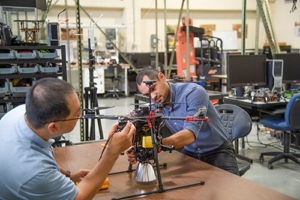UTA IS REVOLUTIONIZING CITY MAINTENANCE
When a 66-inch sewer line broke in Arlington, Texas’ Interlochen neighborhood in 2016, the city decided that rather than tearing up miles of sewer mains and a community, it would partner for a smarter solution.

City of Arlington workers teamed up with the University of Texas at Arlington (UTA) to deploy a sensor-laden floating robot to scan the sewer system and gather data that was then analyzed by researchers at UTA. The research team, led by UTA civil engineering chair Ali Abolmaali, developed software that allowed the team to predict the remaining lifespan of existing pipes.
The system saved the city roughly $17 million, Abolmaali estimates.
“Before, if they doubted [the integrity of sewer lines], they would replace the entire line,” he says.
The sewer robot drone was also deployed in the mains in Arlington’s entertainment district, which includes AT&T Stadium and Globe Life Park, the new Texas Rangers stadium.
The City of Houston has signed a contract to deploy the robots to analyze portions of its sewer system, says Walter “Buzz” Pishkur, retired city water utility director of the City of Arlington. Pishkur says the program could revolutionize how city sewer lines are maintained.
This article is part of the 2020 Higher Education Review Magazine.